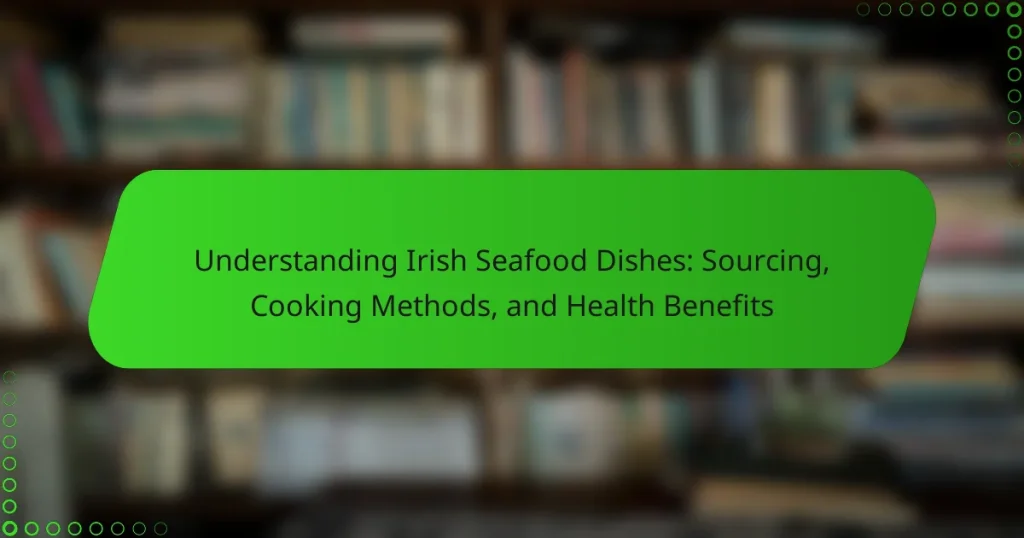Irish seafood dishes encompass a variety of preparations that feature fresh fish and shellfish, including cod, salmon, mussels, and oysters. Traditional recipes such as seafood chowder and fish and chips highlight the region’s culinary heritage, while sustainable fishing practices ensure the availability of high-quality ingredients. Common cooking methods like boiling, grilling, baking, and frying enhance the natural flavors of the seafood. Additionally, Irish seafood is rich in omega-3 fatty acids, lean protein, and essential vitamins, offering numerous health benefits that contribute to overall well-being. This article explores the sourcing, cooking methods, and nutritional advantages of Irish seafood cuisine.

What are Irish Seafood Dishes?
Irish seafood dishes include a variety of preparations featuring fresh fish and shellfish. Common ingredients are cod, salmon, mussels, and oysters. Traditional dishes include seafood chowder, which combines various fish with cream and vegetables. Another popular dish is fish and chips, featuring battered and fried fish served with potatoes. Irish people also enjoy smoked salmon on brown bread. The coastal regions provide abundant seafood due to the surrounding Atlantic Ocean. This access to fresh ingredients enhances the quality of Irish seafood dishes. Many recipes have been passed down through generations, showcasing cultural heritage.
How are Irish Seafood Dishes defined culturally?
Irish seafood dishes are culturally defined by their historical connection to the sea and local traditions. The coastal geography of Ireland influences the abundance of seafood available. Traditional methods of fishing and foraging are integral to Irish culinary practices. Recipes often reflect regional variations, showcasing local ingredients. Seafood is celebrated in festivals, highlighting its cultural significance. Dishes like fish and chips or seafood chowder are staples in Irish cuisine. The use of fresh, sustainable seafood aligns with contemporary culinary values. Overall, these dishes embody a rich heritage that connects communities to their maritime environment.
What ingredients are commonly used in Irish Seafood Dishes?
Common ingredients in Irish seafood dishes include fish, shellfish, potatoes, and seaweed. Fish varieties often used are cod, haddock, and salmon. Shellfish such as mussels, oysters, and prawns are also popular. Potatoes serve as a staple side or ingredient in many recipes. Seaweed is frequently utilized for flavor and nutritional benefits. Irish cuisine emphasizes fresh, locally sourced seafood. This focus on local ingredients enhances the quality and taste of the dishes.
How do regional variations influence Irish Seafood Dishes?
Regional variations significantly influence Irish seafood dishes by determining the types of seafood available and the cooking methods used. Coastal areas like Galway and Cork showcase local catches such as mussels and oysters. These regions often prepare seafood using traditional methods like steaming or grilling, enhancing natural flavors. In contrast, inland areas may rely on preserved seafood or freshwater fish, leading to different dish compositions.
Additionally, local culinary traditions shape seasoning and presentation styles. For instance, the influence of French cuisine in some areas introduces richer sauces. Historical factors, such as trade routes and fishing practices, also impact regional seafood dishes. These variations reflect the diversity of Ireland’s maritime heritage and local culture.
Why are Irish Seafood Dishes significant in Irish cuisine?
Irish seafood dishes are significant in Irish cuisine due to the country’s rich maritime heritage. Ireland’s extensive coastline provides access to a diverse range of seafood. Traditional dishes often highlight local catches, such as salmon, cod, and shellfish. Seafood has been a staple in Irish diets for centuries. Historical records show that fishing was a vital industry in Ireland as early as the 12th century. The use of seafood in Irish cooking reflects regional flavors and seasonal availability. Many Irish seafood recipes emphasize simplicity, allowing the natural flavors to shine. Additionally, seafood is a source of essential nutrients, contributing to health and well-being. This connection to the sea underscores the cultural identity of Ireland.
What historical factors have shaped the development of Irish Seafood Dishes?
Irish seafood dishes have been shaped by various historical factors. The long coastline of Ireland has provided abundant access to seafood. This geographical advantage facilitated fishing as a primary food source for centuries. The Viking invasions in the 8th and 9th centuries introduced new fishing techniques and preservation methods. The establishment of trade routes during the Middle Ages expanded the variety of seafood available. The Great Famine in the 19th century shifted dietary practices, leading to a focus on local seafood. Additionally, cultural influences from British and European cuisines have integrated into Irish seafood dishes. Traditional methods such as smoking and curing have been passed down through generations. These factors collectively influenced the evolution of seafood cuisine in Ireland.
How do Irish Seafood Dishes reflect local traditions and customs?
Irish seafood dishes reflect local traditions and customs through their sourcing and preparation methods. Coastal communities have relied on fishing for generations. The use of locally caught fish, such as cod and haddock, showcases the connection to the sea. Traditional recipes often include ingredients that are native to the region. For instance, Irish chowder incorporates potatoes, a staple in Irish cuisine.
Seasonal availability influences the types of seafood used in dishes. Festivals celebrating seafood, like the Galway International Oyster and Seafood Festival, highlight cultural significance. Cooking methods, such as steaming or baking, are often passed down through families. These practices maintain a strong link to heritage and community identity.
Overall, Irish seafood dishes serve as a culinary reflection of the country’s rich maritime history and local customs.

How is Irish Seafood Sourced?
Irish seafood is sourced through sustainable fishing practices and aquaculture. The fishing industry adheres to strict regulations to protect marine ecosystems. Fishermen utilize various methods, including trawling, potting, and netting, to catch species like cod, haddock, and shellfish. Aquaculture operations cultivate seafood such as mussels and oysters in controlled environments. The Marine Institute monitors fish stocks to ensure sustainability. Reports indicate that over 90% of Irish seafood is sustainably sourced. This commitment helps maintain biodiversity and supports local economies.
What methods are used to source seafood in Ireland?
Seafood in Ireland is sourced primarily through fishing and aquaculture. Commercial fishing involves various methods such as trawling, netting, and potting. Trawling uses large nets dragged through the water to catch fish. Netting involves setting stationary nets to capture fish as they swim by. Potting targets species like crab and lobster using baited traps. Aquaculture, or fish farming, is also significant in Ireland. It includes the cultivation of shellfish and finfish in controlled environments. The Irish Sea is a vital area for both fishing and aquaculture. These methods ensure a diverse supply of seafood for local and export markets.
How do sustainability practices impact seafood sourcing in Ireland?
Sustainability practices significantly impact seafood sourcing in Ireland by promoting responsible fishing methods. These practices help to ensure the long-term viability of fish populations. For instance, the use of quotas and size limits prevents overfishing. Sustainable sourcing also encourages the protection of marine ecosystems. This approach aligns with consumer demand for ethically sourced seafood. According to the Marine Institute, sustainable practices lead to healthier fish stocks. They report that properly managed fisheries can increase biodiversity. Additionally, sustainability initiatives support local economies by fostering community-based fishing. Overall, these practices enhance the quality and availability of seafood in Ireland.
What role do local fisheries play in sourcing Irish Seafood?
Local fisheries are crucial in sourcing Irish seafood. They provide fresh, high-quality fish and shellfish directly from the surrounding waters. These fisheries support local economies by creating jobs and sustaining communities. Local fishermen adhere to sustainable practices, ensuring the long-term health of marine ecosystems. The Irish Sea is home to diverse species, including cod, haddock, and shellfish. These fisheries contribute to the unique flavors found in traditional Irish seafood dishes. According to the Marine Institute, local fisheries contribute significantly to the overall seafood supply in Ireland. This connection enhances the authenticity and freshness of Irish cuisine.
What are the challenges faced in sourcing Irish Seafood?
Sourcing Irish seafood faces several challenges. Overfishing is a significant concern, affecting sustainability. Climate change impacts fish populations and their habitats. Regulatory compliance can be complex and burdensome for suppliers. Market demand fluctuates, leading to supply inconsistencies. Additionally, quality control is critical, as freshness affects consumer preferences. Geographic isolation can hinder access to certain seafood varieties. Finally, environmental factors, such as pollution, threaten marine ecosystems.
How do environmental changes affect seafood availability?
Environmental changes significantly affect seafood availability. Factors such as rising sea temperatures, ocean acidification, and pollution alter marine ecosystems. Warmer waters can shift fish populations to cooler areas, reducing local catches. Ocean acidification impacts shellfish growth and survival rates. Additionally, pollution can lead to harmful algal blooms, which further diminish seafood supplies. According to the FAO, climate change could reduce global fishery yields by up to 30% by 2030. These changes disrupt traditional fishing patterns and threaten food security for communities reliant on seafood.
What regulations govern seafood sourcing in Ireland?
The regulations governing seafood sourcing in Ireland include the European Union’s Common Fisheries Policy (CFP). The CFP aims to ensure sustainable fishing practices and manage fish stocks effectively. In addition, Ireland adheres to the Sea-Fisheries and Maritime Jurisdiction Act 2006. This act implements EU regulations and sets out national guidelines for fishing activities. The Marine Institute also plays a role in monitoring and assessing fish stocks. Compliance with these regulations helps protect marine ecosystems and ensures seafood quality. Regular inspections and licensing are part of the enforcement mechanisms in place. These measures contribute to responsible sourcing of seafood in Ireland.

What are the common Cooking Methods for Irish Seafood Dishes?
Common cooking methods for Irish seafood dishes include boiling, grilling, baking, and frying. Boiling is often used for shellfish like mussels and prawns. Grilling adds a smoky flavor to fish such as salmon and mackerel. Baking is a popular method for preparing whole fish, allowing for even cooking. Frying is commonly used for fish and chips, providing a crispy texture. These methods highlight the fresh flavors of the seafood and are traditional in Irish cuisine.
How are traditional cooking methods applied to Irish Seafood?
Traditional cooking methods for Irish seafood include steaming, baking, and boiling. Steaming preserves the natural flavors and nutrients of the seafood. This method is commonly used for shellfish like mussels and clams. Baking is often applied to fish such as cod and salmon, enhancing their taste while keeping them moist. Boiling is frequently used for preparing seafood chowders, a traditional Irish dish. These methods reflect Ireland’s coastal heritage and emphasize fresh, local ingredients. Historical practices show that these cooking techniques have been passed down through generations, maintaining cultural significance.
What techniques are used for grilling and baking seafood?
Grilling and baking seafood involve specific techniques that enhance flavor and texture. Grilling seafood typically utilizes direct heat, which imparts a smoky flavor and creates appealing grill marks. Common methods include using a grill pan or an outdoor grill. Baking seafood involves cooking in an oven, often at temperatures around 350°F to 450°F. This method allows for even cooking and can incorporate various seasonings and toppings.
Proof of these techniques’ effectiveness can be found in culinary practices worldwide. For instance, grilling fish like salmon or shrimp often results in a crisp exterior while maintaining moisture inside. Baking white fish with herbs and lemon can enhance its delicate flavors while ensuring it remains tender. These methods are favored for their ability to preserve the natural taste of seafood.
How do boiling and steaming enhance the flavors of seafood?
Boiling and steaming enhance the flavors of seafood by preserving its natural moisture and delicate taste. These cooking methods utilize water or steam, which helps maintain the seafood’s texture and prevents it from drying out. The gentle heat allows the seafood to cook evenly without losing essential oils and flavors. Boiling can also infuse seafood with additional flavors if herbs or spices are added to the cooking water. Steaming, on the other hand, retains the seafood’s nutrients while enhancing its natural sweetness. According to culinary studies, seafood cooked using these methods shows improved flavor retention compared to frying or grilling.
What modern cooking methods are popular for Irish Seafood?
Popular modern cooking methods for Irish seafood include grilling, steaming, and sous-vide. Grilling enhances the natural flavors and adds a smoky taste. Steaming preserves the moisture and nutrients of the seafood. Sous-vide allows for precise temperature control, resulting in tender and flavorful dishes. These methods are widely used in contemporary Irish cuisine. They align with the trend towards healthier cooking practices. Each method highlights the freshness of locally sourced seafood.
How does sous-vide cooking affect the texture of seafood?
Sous-vide cooking significantly enhances the texture of seafood. This method involves vacuum-sealing seafood in a bag and cooking it in a water bath at a precise temperature. The gentle cooking process helps maintain moisture and prevents overcooking. As a result, seafood retains a tender and flaky texture. Studies show that sous-vide can improve the overall mouthfeel of fish and shellfish. The controlled environment reduces the risk of toughening proteins, which is common in traditional cooking methods. This technique also allows for even cooking throughout the seafood. Therefore, sous-vide cooking is ideal for achieving optimal texture in seafood dishes.
What innovations are being introduced in seafood preparation?
Innovations in seafood preparation include the use of sous-vide cooking techniques. This method allows for precise temperature control, enhancing flavor and texture. Additionally, advancements in aquaponics are enabling sustainable seafood farming. These systems integrate fish and plant cultivation, reducing environmental impact. Another innovation is the application of high-pressure processing (HPP). HPP extends shelf life while preserving nutrients and taste. Furthermore, the use of plant-based seafood alternatives is gaining traction. These innovations cater to dietary preferences and sustainability concerns. Together, these methods are transforming seafood preparation in modern culinary practices.

What Health Benefits do Irish Seafood Dishes offer?
Irish seafood dishes offer numerous health benefits. They are rich in omega-3 fatty acids, which support heart health. Consuming seafood can lower blood pressure and reduce the risk of heart disease. Irish seafood is also a good source of lean protein, essential for muscle growth and repair. Additionally, seafood contains important vitamins and minerals, including vitamin D and iodine. These nutrients contribute to bone health and thyroid function. Regular consumption of seafood is associated with improved cognitive function and reduced inflammation. Studies indicate that people who eat seafood regularly have a lower risk of chronic diseases.
How do the nutritional values of Irish Seafood contribute to health?
Irish seafood is rich in essential nutrients that contribute significantly to health. It provides high-quality protein, which is vital for muscle maintenance and repair. Omega-3 fatty acids found in fish promote heart health by reducing blood pressure and inflammation. Additionally, Irish seafood is a good source of vitamins and minerals, including vitamin D and iodine, which support bone health and thyroid function. Regular consumption of seafood is linked to a lower risk of chronic diseases, such as cardiovascular issues and certain cancers. Studies indicate that populations with higher seafood intake tend to have improved overall health outcomes.
What essential nutrients are found in common Irish seafood?
Common Irish seafood contains essential nutrients such as omega-3 fatty acids, protein, iodine, and vitamins. Omega-3 fatty acids support heart health and brain function. Protein is crucial for muscle repair and growth. Iodine is essential for thyroid function and metabolism. Vitamins A and D are also present, promoting vision and bone health. Shellfish, such as mussels and oysters, are particularly high in zinc and vitamin B12, which support immune function and energy metabolism. These nutrients contribute to a balanced diet and overall health.
How does seafood consumption affect heart health?
Seafood consumption positively affects heart health. It is rich in omega-3 fatty acids, which lower triglycerides and reduce blood pressure. Regular intake of seafood is linked to a lower risk of heart disease. Studies show that people who eat seafood have a 36% reduced risk of cardiovascular events. Fatty fish, such as salmon and mackerel, provide high levels of these beneficial fats. The American Heart Association recommends eating fish at least twice a week for optimal heart health. This dietary choice can also improve overall cholesterol levels. Thus, seafood is a heart-healthy food choice.
What are the potential risks associated with consuming seafood?
Consuming seafood can pose several potential risks. One major risk is exposure to heavy metals, such as mercury. High levels of mercury can lead to neurological damage, particularly in pregnant women and young children. Seafood can also carry harmful bacteria and viruses, leading to foodborne illnesses. For instance, Vibrio bacteria can cause severe gastrointestinal issues. Additionally, some seafood may contain environmental contaminants like polychlorinated biphenyls (PCBs), which are linked to cancer and other health problems. Allergic reactions are another risk, as certain individuals may be allergic to shellfish or fish proteins. Lastly, overconsumption of certain types of seafood can lead to imbalances in omega-3 fatty acids and other nutrients.
How can consumers ensure the seafood they eat is safe?
Consumers can ensure the seafood they eat is safe by purchasing from reputable sources. Look for seafood that is certified by organizations such as the Marine Stewardship Council. Check for freshness indicators like clear eyes and a mild ocean smell. Avoid seafood that has a strong, fishy odor or discolored flesh. Additionally, consumers should inquire about the seafood’s origin and handling practices. Proper cooking temperatures also play a crucial role; seafood should be cooked to an internal temperature of 145°F (63°C) to kill harmful bacteria. Following these guidelines can significantly reduce the risk of foodborne illnesses associated with seafood.
What guidelines should be followed for seafood consumption?
Consume seafood that is sourced sustainably. Check for certifications like Marine Stewardship Council (MSC). Avoid overfished species to support marine ecosystems. Limit consumption of high-mercury fish such as shark or swordfish. Opt for a variety of seafood to reduce exposure to contaminants. Cook seafood to an internal temperature of 145°F to ensure safety. Refrigerate seafood promptly and consume within two days of purchase. Follow local advisories regarding seafood caught in contaminated waters.
What are some practical tips for enjoying Irish Seafood Dishes?
To enjoy Irish seafood dishes, focus on freshness and local sourcing. Visit fish markets or local fisheries for the best options. Pair seafood with traditional Irish ingredients like potatoes and soda bread. Experiment with classic cooking methods, such as grilling or steaming, to enhance flavors. Use herbs like dill and parsley for seasoning. Consider enjoying seafood with a glass of Irish stout or white wine for a complementary experience. Pay attention to the seasonality of seafood for optimal taste and sustainability. Lastly, savor the dishes slowly to appreciate the unique flavors.
Irish seafood dishes encompass a variety of preparations featuring fresh fish and shellfish, prominently including cod, salmon, mussels, and oysters. The article explores the cultural significance, sourcing methods, cooking techniques, and health benefits associated with these dishes, highlighting their historical roots and regional variations across Ireland. It emphasizes sustainable practices in seafood sourcing and outlines common cooking methods such as boiling, grilling, and baking, while discussing the nutritional value and potential risks of seafood consumption. Overall, the article provides a comprehensive understanding of Irish seafood dishes, their preparation, and their role in promoting health and cultural heritage.


